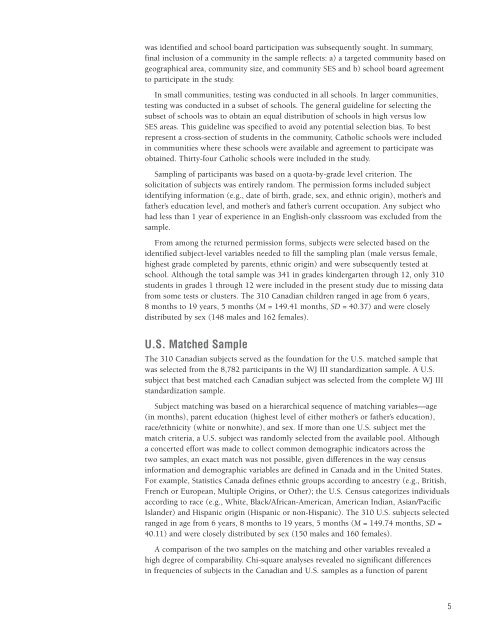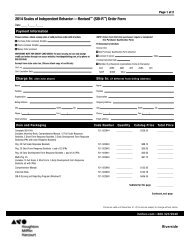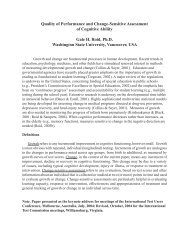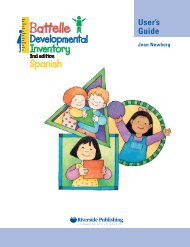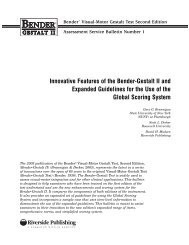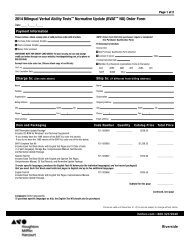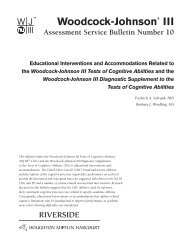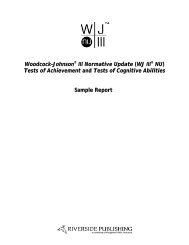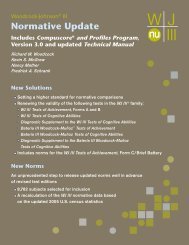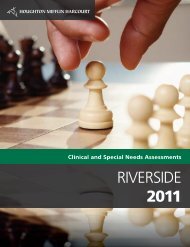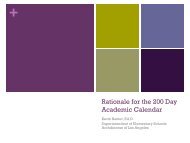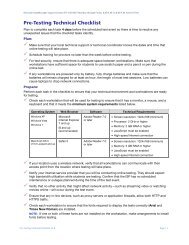Woodcock-Johnson® III - Riverside Publishing
Woodcock-Johnson® III - Riverside Publishing
Woodcock-Johnson® III - Riverside Publishing
- No tags were found...
You also want an ePaper? Increase the reach of your titles
YUMPU automatically turns print PDFs into web optimized ePapers that Google loves.
was identified and school board participation was subsequently sought. In summary,final inclusion of a community in the sample reflects: a) a targeted community based ongeographical area, community size, and community SES and b) school board agreementto participate in the study.In small communities, testing was conducted in all schools. In larger communities,testing was conducted in a subset of schools. The general guideline for selecting thesubset of schools was to obtain an equal distribution of schools in high versus lowSES areas. This guideline was specified to avoid any potential selection bias. To bestrepresent a cross-section of students in the community, Catholic schools were includedin communities where these schools were available and agreement to participate wasobtained. Thirty-four Catholic schools were included in the study.Sampling of participants was based on a quota-by-grade level criterion. Thesolicitation of subjects was entirely random. The permission forms included subjectidentifying information (e.g., date of birth, grade, sex, and ethnic origin), mother’s andfather’s education level, and mother’s and father’s current occupation. Any subject whohad less than 1 year of experience in an English-only classroom was excluded from thesample.From among the returned permission forms, subjects were selected based on theidentified subject-level variables needed to fill the sampling plan (male versus female,highest grade completed by parents, ethnic origin) and were subsequently tested atschool. Although the total sample was 341 in grades kindergarten through 12, only 310students in grades 1 through 12 were included in the present study due to missing datafrom some tests or clusters. The 310 Canadian children ranged in age from 6 years,8 months to 19 years, 5 months (M = 149.41 months, SD = 40.37) and were closelydistributed by sex (148 males and 162 females).U.S. Matched SampleThe 310 Canadian subjects served as the foundation for the U.S. matched sample thatwas selected from the 8,782 participants in the WJ <strong>III</strong> standardization sample. A U.S.subject that best matched each Canadian subject was selected from the complete WJ <strong>III</strong>standardization sample.Subject matching was based on a hierarchical sequence of matching variables—age(in months), parent education (highest level of either mother’s or father’s education),race/ethnicity (white or nonwhite), and sex. If more than one U.S. subject met thematch criteria, a U.S. subject was randomly selected from the available pool. Althougha concerted effort was made to collect common demographic indicators across thetwo samples, an exact match was not possible, given differences in the way censusinformation and demographic variables are defined in Canada and in the United States.For example, Statistics Canada defines ethnic groups according to ancestry (e.g., British,French or European, Multiple Origins, or Other); the U.S. Census categorizes individualsaccording to race (e.g., White, Black/African-American, American Indian, Asian/PacificIslander) and Hispanic origin (Hispanic or non-Hispanic). The 310 U.S. subjects selectedranged in age from 6 years, 8 months to 19 years, 5 months (M = 149.74 months, SD =40.11) and were closely distributed by sex (150 males and 160 females).A comparison of the two samples on the matching and other variables revealed ahigh degree of comparability. Chi-square analyses revealed no significant differencesin frequencies of subjects in the Canadian and U.S. samples as a function of parent5


